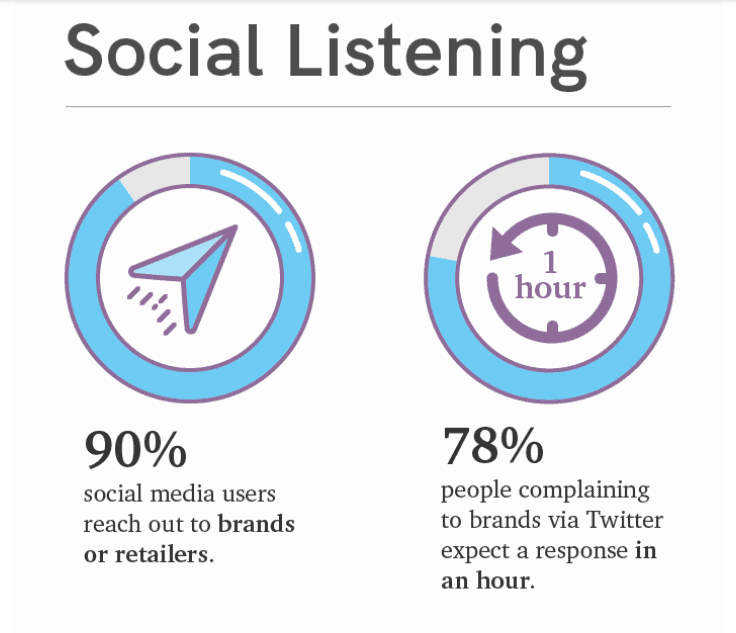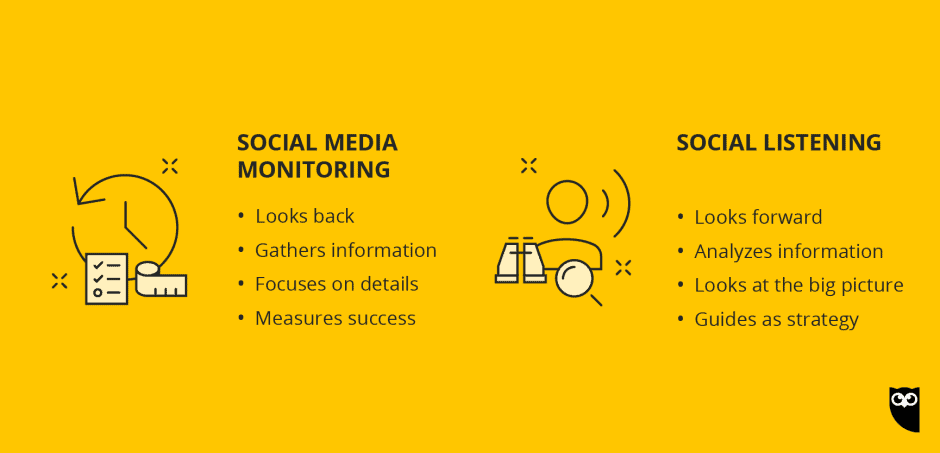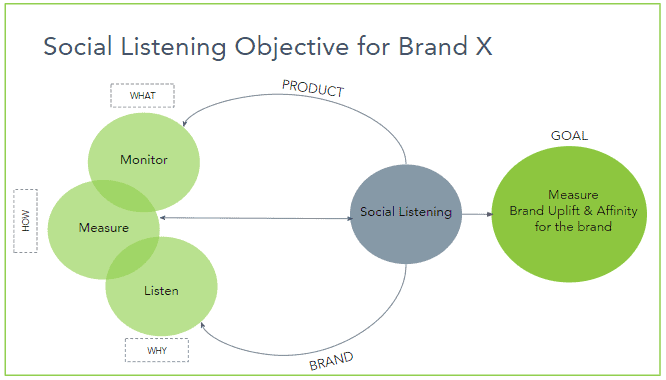Humans have nearly unlimited wants. They’re bound to desire something new entirely or improvements in current offerings. Thanks to this human tendency, the Business Market has always been dynamic; driven by the wants of consumers.
In order to sell more and sell quickly, it is important for a business to be aware of the changes taking place in what people desire. Having an insight into changing wants and desires of people, enables a business to make adjustments to its offerings in anticipation of incoming changes.
[playht_player width=”100%” height=”175″ voice=”Mark”]
Knowing and understanding the changing consumer wants, desires, habits and expectations is what social media listening is. When implemented properly, a good social media listening strategy will enable a business to know what their consumers expect from them. This way the business can better deliver on those expectations without any delays.
Happy and satisfied consumers are the key to a healthy, long term existence of any business entity!
What is Social Media Listening?

Source: The Social Shake Up
It is 2025 and it doesn’t matter if your business has an online presence or not; if you’re selling something, your consumers are bound to talk and discuss it online. Them talking and discussing your products is beneficial for you as a business as it helps you understand how you’re doing good and how you can improve further.
Social monitoring helps you gather data by monitoring all of the internet for mentions of your brands, products or about consumer expectations from your industry. The data collected is a lot and needs to be analysed in time for it to be relevant.
Interpreting all this analysed data to better understand what consumers expect from you and the industry as a whole is what Social Listening is. Social Listening provides insight into what changes are to come in the industry and a business can use these insights to usher in these new trends and become the segment leader.
In layman’s terms, Social Listening is “listening and understanding” everything that is being said about your brand and industry in the online space. Basically, listen to your consumer feedback inorder to improve your business prospects.
Social Listening is an impactful tool that provides transformative benefits to your business but as most people aren’t well versed with it’s ‘how to’s, it remains underutilized. That’s where we come in, to introduce you to Social Listening and help you build a potent Social Listening Strategy to help you become the market leader.
Social Listening vs Social Monitoring

Source: Hootsuite
Often confused to be synonymous, Social Listening and Social Monitoring are entirely different processes. In essence, undertaking the process of Social Monitoring is what enables a business to perform the process of Social Listening.
The main objective of Social Monitoring is to observe all the interactions that happen online relating to your brand and industry. By observing these interactions, we are collecting data regarding the position your brand has in the market. Customer Feedback thus collected helps in the further process of Social Listening.
Social Listening takes this collected data and further analyses it for the process of interpretation and analysing. Understanding and interpreting this information gathered out of numerous online interactions grants the business insight into current market conditions and what changes to expect in the oncoming future.
Social Monitoring observes and collects data while Social Listening further processes this data and interprets it to enable better business decision making by providing insights about the forces driving the market.
Social Listening Strategy

Source: The S.M.G.
Social Media usage has skyrocketed since the pandemic began in the March of 2020 and there are no signs that it may ever go back to the previous levels. What this means for the businesses is that there are more consumers online and it is easier to reach through digital means.
Social Listening was already a potent tool and with the rise in Social Media usage, it’s only going to become more effective. It still is underutilized as most marketers are unaware of its ‘how to’s’. So, here we are, to help you build an effective Social Listening Strategy.
- Identifying and Setting Objectives: Be it any strategy, it always begins with identifying what all needs to be achieved and what all among it can be achieved. Knowing what all needs to be achieved and in what time frame is important to maximise the output and efficiency of Social Listening.
Some mainstream objectives that Social Listening can achieve are:
- Market Intelligence
- Lead Generation
- Customer Service and Reputation Management
Having a well defined set of objectives and a roadmap to accomplish each one of those enables one to properly channel the efforts and limited resources of a business in the right direction.
Knowing well what needs to be accomplished will help you choose the right keywords, brand terms and types of interactions to monitor. Each element of the Social Listening Strategy, when set properly, will ensure you land ahead of your competition and lead the segment while being ahead.
- Market Intelligence: Unlike other sources of information and data, Social Listening Tools monitor the entire internet for mentions of your brand, of competitors and the industry at large. The sources are diverse and the sample pool is widespread.
One advantage of data collected from Social Listening Tools is that the data is sourced from the primary consumer and hence does not suffer from the drawbacks of bias, misreporting or aggregation.
Market Intelligence serves two main purposes:
i) Helps Identify Actual Target Consumers: There exists a drastic difference in the image of a potential consumer the Marketing or Sales team may have in their minds and the consumers who are actually buying their products and services.
This often leads to marketing campaigns being ineffective as the Marketers fail to identify and target the actual potential consumers. Programming Social Monitoring Tools to find mentions of your brand and a few of your competitors helps identify the people who’re actually using your products.
One can then segment these people as per determined demographic parameters to ensure their business is targeting the right set of consumers and that their marketing efforts and resources aren’t being wasted.
ii) Tracking Trends: Trends are started on social media and the ripples are felt everywhere on the internet. The only effective way of tracking trends is using Social Listening. Social Listening will flag a new trend as soon as it notices posts and #tags of your competitors gaining significant attention.
A business can respond to a trend quickly and make most of the windfall gains or they could initiate a counter trend to ensure they can effectively cannibalise their competitors’ market shares.
The trick here is quick identification of trends and a swift response to it. Responding late to any trend makes a brand look desperate for attention and leads to loss of good sentiment.
Lead Generation: Social listening doesn’t come to one’s mind when thinking about lead generation but in the coming years, Social Listening is sure to end up as the most prominent tool for lead generation; all thanks to the surge in social media usage.
Source: Auris
Here’s how it works:
i) Find people who are talking/asking about your product: People on the internet talk a lot about the products they use and even ask around for recommendations before buying a product. Identifying these people who are already looking out for your product and then engaging with them using product information and guiding them towards the sales team ensures the leads get converted.
Setting up your Social Listening tool to track these mentions is really important in order to have a good, convertible list of leads. It is necessary to ensure that you set up the tool to find a wide variation of search queries. One can even utilise Boolean Search to accomplish this.
ii) Find consumers dissatisfied with your competitors’ products: The market has a limited number of consumers. The secondary way of increasing your market share is to lure away consumers from our competitors. There are always going to be consumers who are unhappy with the product or service your competitors have sold them, so it’s essential to monitor and manage customer feedback to identify and track them down.
One can engage with these consumers and try to lure them by providing product or service demos or by offering additional discounts or benefits for leaving your competitor and switching over to you. The key here is to provide them with the value they aren’t receiving from the competition.
- Customer Service and Brand Reputation Management: Social Listening is most widely used to serve the functions of Customer Service and managing the reputation of the brand. The brands are online on social media and so are their consumers, it’s quite natural for the consumers to expect to be heard by the brands on social media.
This setup is beneficial for both, the brands and the consumers, as the processes of grievance redressal, technical support, etc. can be carried out with convenience with minimal requirement of efforts and resources.
Here’s what a business should do:
i) Prompt responses to questions, queries and complaints: One thing that the people of the internet love is quick responses and most of the businesses are trying to capitalise on this. Thanks to this the general expectations for a quick response from the brands to their consumers is quite high.
It may end up costing a significant amount of effort and resources to ensure all customers, present and potential, are reached out to with responses. However, the paybacks are high for the inputs invested. Studies have shown that a big percentage of people will recommend brands that consistently respond quickly to the consumers.
You can get started by optimizing your notifications. It’s beneficial to have a tool where you can manage all of your accounts in one place, whether that be in your inbox or with an automation tool, you can create a robust dashboard to look at social mentions.
ii) Respond to Positive mentions and comments: Many do not consider this to be important however, building and maintaining a good relationship with your consumers, adds to your brand value. A Business should respond to positive comments made about it and thank the consumers for the praise.
Reposting a consumer’s positive post about the brand also acts as an indirect marketing activity. Moreover, showing the customers that you care, listening to everything they have to say and responding to it helps ensure the consumers view you as a reliable brand and builds trust in you.
Final thoughts on social media listening
The Market is like a big community where everyone talks and gossips about each other. It is necessary to know about anything and everything going on in the community if you plan to become the talk of the town!
The only way of making this possible is to keep your ears open to everything and listen carefully. The business world is going to become even more socially influenced than it has ever been. So, treating the Market as a Social community is the only way going forward from here on.
The one who knows the community best prevails at everything! So tell me, are you listening?

